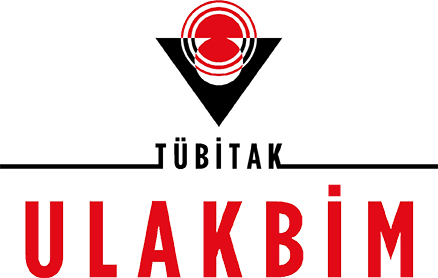Nisan 2013 / (21 - 1)
İnflamatuvar barsak hastalığı tanılı olgularımızda ekstraintestinal tutulum tipleri ve sıklığı
Yazarlar
Atakan YEŞİL
1
, Ebubekir ŞENATEŞ
2
, Kadir KAYATAŞ
3
, Koray KOÇHAN
1, Emrullah Düzgün ERDEM
1
,
Banu ERKALMA ŞENATEŞ
4
, Can GÖNEN
1
Kurumlar
Departments of 1
Gastroenterology and 3
3rd Internal Medicine Clinic Haydarpaşa Numune Education and Research Hospital, İstanbul
Department of 2
Gastroenterology Dicle University Medical School, Diyarbakır
Department of 4
Internal Medicine, Diyarbakır Education and Research Hospital, Diyarbakır
Özet
Amaç: İnflamatuvar barsak hastalıkları; ülseratif kolit ve Crohn hastalığı olarak iki önemli hastalığı içerir. Barsak hastalıkları olarak nitelendirilmelerine
rağmen sistemik tutulumları da mevcuttur. Bu çalışmadaki amacımız kliniğimizde yatırarak takip ettiğimiz inflamatuvar barsak hastalarındaki ekstraintestinal tutulum tiplerini ve sıklığını belirlemek, hastalık aktivitesiyle ilişkisini araştırmaktır. Gereç ve Yöntem:Çalışma gastroenteroloji kliniğimizde
takip ettiğimiz inflamatuvar barsak hastalıkları tanısı olan 85 hasta üzerinde
yapıldı. Hastalar 39 Chron hastası ve 46 ülseratif kolit hastasından oluşmaktaydı. Bulgular:Crohn hastalığı grubu ve ülseratif kolit grubu arasında yaş,
cinsiyet, boy, vücut ağırlığı, beden kitle indeksi, eritrosit sedimentasyon hızı,
C-reaktif protein, hemoglobin, hastalık süresi, ekstraintestinal tutulum sıklığı açısından istatistiksel anlamlı farklılık bulunmadı (p>0.05). Lökosit sayısı
ortalaması Crohn hastalığı grubunda ülseratif kolit grubuna göre anlamlı dü-şük bulundu (p:0.003). Hastalar ekstraintestinal tutulum olup olmamasına
göre ikiye ayrıldığında gruplar arasında yaş, cinsiyet, vücut ağırlığı, beden
kitle indeksi, C-reaktif protein, eritrosit sedimentasyon hızı, hemoglobin, lökosit sayısı, hastalık süresi açısından anlamlı farklılık bulunmadı (p>0.05).
Ekstraintestinal tutulum tipleri sıklık sırasına göre: sakroileit (%40.7), artralji (%11.1), psöriazis (%11.1) artrit (%7.4), ankilozan spondilit (%7.4),
iridosiklit (%7.4), primer sklerozan kolanjit (%3.7) ve üveit (%3.7) şeklindeydi. Hastalarda ekstraintestinal tutulum varlığı ile hastalık aktivitesi, tipi
ve endoskopik tutulum bölgeleri arasında anlamlı ilişki saptanmadı. Sonuç:
Sonuç olarak inflamatuvar barsak hastalarımızda ekstraintestinal tutulum
oranı Crohn hastalığı grubunda %38.46, ülseratif kolit grubunda %26.08
olmak üzere, literatürle uyumlu olarak sıktır. Hastaların tanı aldıkları andan
itibaren ekstraintestinal bulgular açısından düzenli muayene ve takiplerinin
yapılması önemlidir.
Anahtar Kelimeler
Ülseratif kolit, Crohn hastalığı, ekstraintestinal tutulum
Giriş
Inflammatory bowel disease (IBD) is a group of chronic inflammatory diseases in genetically predisposed individuals
characterized by an unknown etiology and mechanism and
chronic periods of remission and exacerbation. It includes
two important diseases - ulcerative colitis (UC) and Crohn’s
disease (CD) (1-3).
Although they are described as bowel diseases, they also have
systemic involvement. This clinical condition, also called extraintestinal involvement, includes a broad spectrum of involvement that ranges from mild to severe. The relationship
between the severity of extraintestinal involvement and the
severity of the underlying bowel disease shows differences according to the type of involvement. Joint (excluding axial),
mouth, eye and skin involvement is associated with disease
activity and they are referred to as inflammatory diseases (4).
Areas of involvement other than these are generally not associated with disease activity; the underlying mechanism is attributed to autoimmune, nutritional and metabolic causes(4).
While the most important variables related to extraintestinal
involvement in UC are extent of colonic involvement and disease activity, the variables in CD are multifactorial (5).
Our aim in this study was to determine the types and frequencies of extraintestinal involvement in IBD cases followed
after admission to our clinic and to investigate the relationship between extraintestinal involvement and disease activity.
Olgu
In the studies investigating the frequency of extraintestinal
involvement in IBD patients, it was reported that systemic involvement was present in approximately one-third of the patients (6,7). Depending upon the areas of reporting, this rate
ranges between 20% and 40% (6). We determined this rate as
32% in this study conducted on the patients followed up after
admission in our clinic. Although the extraintestinal involvement rate in the patients with CD (38.46%) was higher than
in the UC group (26.08%), the difference between them was
not statistically significant.
In the studies performed, joint involvement was reported to
be the most frequent involvement encountered in IBD, with
a rate of 10-30% (8). Joint involvement in IBD can be axial, peripheral or combined. Peripheral arthritis is generally
nonerosive, oligoarticular and shows a parallelism with disease activity. Axial arthritis can be grouped as inflammatory
back pain, sacroiliitis and ankylosing spondylitis (9). In our
patient group, extraintestinal involvement was seen in 27 of
85 patients, and in 11 of those 27 (40%), the involvement
was sacroiliitis. The frequency of sacroiliitis in different published studies ranges from 10-32% (8-12). The reason for this
wide range may be due to some of the studies being population-based and others hospital-based, variability of activity status of the patients and geographical differences. In this
study, we determined the prevalence of sacroiliitis as 11/85,
namely 12%. However, no prominent extraintestinal involvement other than sacroiliitis was observed. The prevalences of
arthralgia and psoriasis were determined to be approximately
3.5%. We determined the frequency of erythema nodosum as
2.3%, and the frequencies of uveitis and primary sclerosing
cholangitis as 1.2%, similar to each other. These rates showed
similarity with many studies in the literature (8-15).
In this study, there was no significant difference between the
CD patients with and without extraintestinal involvement regarding disease activity, type of disease, CDAI, CDES index
and areas of involvement on endoscopy. There was no significant difference between the UC patients with and without extraintestinal involvement regarding disease activity (according to Truelove and Witts’ criteria), Mayo index, and areas
of involvement on endoscopy. These findings show us that
there is no correlation between the presence of extraintestinal
involvement and the disease activity, type of the disease and
mucosal healing in the IBD cases followed up in our clinic.
The major limitation in our study is the small sample size
and the nonhomogeneity of the patient population due to
their selection from the patients admitted to our clinic. Despite the present limitations, this study shows that frequencies of extraintestinal involvement are high in IBD patients
independent of the parameters of disease activity, type of the
disease and areas of involvement on endoscopy. Our results
call attention to the importance of regular examination and
follow-up of the patients, from the time of diagnosis, regarding extraintestinal symptoms
Gereç ve Yöntem
A total of 85 patients (42 females, 43 males) with IBD diagnosis who were followed after admission to our Gastroenterology Clinic (mean age: 36.64±12.54; min: 16, max: 74 years)
were included in the study. The patients, matched for age
and gender, were divided into two groups according to the
type of IBD. Group 1 included 39 patients (22 females, 17
males) with CD, and Group 2 included 46 patients (20 females, 26 males) with UC. All cases were informed about the
study protocol, and written informed consent was obtained
from all cases included in the study. A form for each patient
was filled, inquiring about their age, gender, type and duration of the disease, area and extent of disease involvement in
the bowel, any medicines used to treat IBD, and any history
or not of a surgical operation. A general physical examination
and locomotor system examinations were performed. Venous
blood samples were drawn into EDTA tubes, sodium citrate
tubes and gel-containing tubes (Becton Dickinson, USA) between 08:00-08:30 a.m. after a 10-12-hour overnight fasting period. Gel-containing tubes were centrifuged at 3500
rpm (1300 g x 10 minutes) after a 30-minute waiting period.
Complete blood count, C-reactive protein (CRP) and erythrocyte sedimentation rate (ESR) tests were studied without
delay. Complete blood count tests were performed from the
EDTA blood samples of all patients, and ESR rates were measured from sodium citrate blood samples using the Westergren method and Sed Rate Screener 100 device (SRS 100,
Greiner Bio-one GmbH, Austria). CRP measurements were
performed from the serum sample using the nephelometric
method (Immage, Beckman Coulter, USA).
Statistical Analysis
During the assessment of the study data, SPSS (Statistical
Package for the Social Sciences) for Windows 16.0 program
was used for statistical analysis. Student t test was used regarding the comparisons of descriptive statistical methods
(mean ± standard deviation, median (range)) as well as the
intergroup comparisons of parameters with normal distribution, and Mann- Whitney U test was used for the intergroup
comparisons of parameters without normal distribution. Chisquare test or Fisher’s exact probability test was used for the
intergroup comparisons of qualitative data. Pearson correlation analysis or Spearman’s rho correlation test was used
in the correlation analyses according the distribution of the
parameters. The results were evaluated in 95% confidence
interval and at a significance level of p<0.05
Sonuçlar
The mean age of the patients with CD (Group 1) was
36.67±12.07 (min: 19, max: 63) years, and the mean age of
the patients with UC (Group 2) was 36.61±13.06 (min: 16,
max: 74) years. There was no statistically significant difference between the groups regarding age and gender (p: 0.983,
0.235, respectively).
There was no statistically significant difference between Group
1 and Group 2 regarding height, body weight, body mass index (BMI), ESR, CRP, hemoglobin (Hb), disease duration, and
the frequency of extraintestinal involvement (p>0.05). Average
white blood cell (WBC) count was 7.28±2.07/mm3 in Group
1 and 8.78±2.33/mm3 in Group 2, and the difference between
them was found to be statistically significant (p=0.003).
Demographic and clinical characteristics and laboratory data
of Group 1 and Group 2 are seen in Table 1.
Patients were divided into two groups regarding the presence or
not of extraintestinal involvement. Group A (with extraintestinal involvement) comprised 27 patients (16 females, 11 males),
and Group B (without extraintestinal involvement) comprised
58 patients (26 females, 32 males). The mean age of Group A
was 37.41±13.52 (min: 19, max: 70) years, and the mean age of
Group B was 36.28±13.16 (min: 16, max: 74) years. There was
no statistically significant difference between groups regarding
age and gender (p: 0.701, 0.215, respectively).
There was no statistically significant difference between
Group A and Group B regarding body weight, BMI, ESR,
CRP, Hb, WBC, or disease duration (p>0.05). Mean height
was 164.81±7.05 cm in Group A and 168.34±6.70 cm in
Group B, and the difference between them was found to be
statistically significant (p=0.029).
Demographic and clinical characteristics and laboratory data
of the groups with and without extraintestinal involvement
are seen in Table 2.
The types of extraintestinal involvement were investigated,
and were determined as follows, in decreasing order of frequency: sacroiliitis 40.7% (11 patients: 7 CD, 4 UC), arthralgia 11.1% and psoriasis (11.1%). The other types of extraintestinal involvement included arthritis (7.4%), ankylosing
spondylitis (7.4%), iridocyclitis (7.4%), primary sclerosing
cholangitis (3.7%), and uveitis (3,7%).
Types and frequencies of extraintestinal involvement seen in
our study group are shown in Table 3.
When the disease activity of the patients with UC was evaluated according to Truelove and Witts’ criteria, mild, moderate and severe disease activity was determined in 12 (26.1%),
23 (27.1%) and 11 (12.9%) patients, respectively. When the
disease activity of the patients was evaluated according to the
Mayo scoring system, the numbers of patients with a score of
0, 1, 2, and 3 were 5 (10.9%), 4 (8.7%), 24 (52.2%), and 13
(28.3%), respectively. Areas of involvement on endoscopy were
as follows: rectum in 4 patients, distal colon in 10 patients, left
colon in 15 patients, and entire large intestine in 17 patients.
There was no significant difference between the UC patients
with and without extraintestinal involvement regarding disease activity, Mayo index and areas of involvement on endoscopy (p: 0.902, 0.632, and 0.645, respectively).
When the disease activity of the patients with CD was investigated, inactive, mild and moderate disease activity was determined in 22 (56.4%), 9 (23.1%) and 8 (20.5%) patients,
respectively. The types of CD were as follows: inflammatory in
18 patients (47.4%), obstructive in 10 patients (26.3%), fistulizing in 9 patients (23.7%), fibrotic in 1 patient (2.6%), and
unknown 1 patient (2.6%). Areas of involvement on endoscopy were as follows: normal in 4 patients, colonic in 6 patients,
ileal in 13 patients, and ileocolonic in 14 patients. There was no significant difference between the CD patients
with and without extraintestinal involvement regarding disease activity, type of disease, Crohn’s Disease Activity Index (CDAI), Crohn’s Disease Endoscopic Index of Severity
(CDEIS) and areas of involvement on endoscopy (p=0.352,
0.427, 0.522, 0.959, and 0.988, respectively).
Tartışma
In the studies investigating the frequency of extraintestinal
involvement in IBD patients, it was reported that systemic involvement was present in approximately one-third of the patients (6,7). Depending upon the areas of reporting, this rate
ranges between 20% and 40% (6). We determined this rate as
32% in this study conducted on the patients followed up after
admission in our clinic. Although the extraintestinal involvement rate in the patients with CD (38.46%) was higher than
in the UC group (26.08%), the difference between them was
not statistically significant.
In the studies performed, joint involvement was reported to
be the most frequent involvement encountered in IBD, with
a rate of 10-30% (8). Joint involvement in IBD can be axial, peripheral or combined. Peripheral arthritis is generally
nonerosive, oligoarticular and shows a parallelism with disease activity. Axial arthritis can be grouped as inflammatory
back pain, sacroiliitis and ankylosing spondylitis (9). In our
patient group, extraintestinal involvement was seen in 27 of
85 patients, and in 11 of those 27 (40%), the involvement
was sacroiliitis. The frequency of sacroiliitis in different published studies ranges from 10-32% (8-12). The reason for this
wide range may be due to some of the studies being population-based and others hospital-based, variability of activity status of the patients and geographical differences. In this
study, we determined the prevalence of sacroiliitis as 11/85,
namely 12%. However, no prominent extraintestinal involvement other than sacroiliitis was observed. The prevalences of
arthralgia and psoriasis were determined to be approximately
3.5%. We determined the frequency of erythema nodosum as
2.3%, and the frequencies of uveitis and primary sclerosing
cholangitis as 1.2%, similar to each other. These rates showed
similarity with many studies in the literature (8-15).
In this study, there was no significant difference between the
CD patients with and without extraintestinal involvement regarding disease activity, type of disease, CDAI, CDES index
and areas of involvement on endoscopy. There was no significant difference between the UC patients with and without extraintestinal involvement regarding disease activity (according to Truelove and Witts’ criteria), Mayo index, and areas
of involvement on endoscopy. These findings show us that
there is no correlation between the presence of extraintestinal
involvement and the disease activity, type of the disease and
mucosal healing in the IBD cases followed up in our clinic.
The major limitation in our study is the small sample size
and the nonhomogeneity of the patient population due to
their selection from the patients admitted to our clinic. Despite the present limitations, this study shows that frequencies of extraintestinal involvement are high in IBD patients
independent of the parameters of disease activity, type of the
disease and areas of involvement on endoscopy. Our results
call attention to the importance of regular examination and
follow-up of the patients, from the time of diagnosis, regarding extraintestinal symptoms
Kaynaklar
1. Scaldaferri F, Fiocchi C. Inflammatory bowel disease: progress and
current concepts of etiopathogenesis. J Dig Dis 2007;8:171-8.
2. Hanauer SB. Inflammatory bowel disease: epidemiology, pathogenesis,
and therapeutic opportunities. Inflamm Bowel Dis 2006;12(Suppl
1):S3-9.
3. Xia B, Crusius J, Meuwissen S, Pena A. Inflammatory bowel disease
definition, epidemiology, etiologic aspects, and immunogenetic studies. World J Gastroenterol 1998;4:446-58.
4. Veloso FT. Extraintestinal manifestations of inflammatory bowel disease: do they influence treatment and outcome? World J Gastroenterol
2011;17:2702-7.
5. Vilela EG, Torres HO, Martins FP, Ferrari Mde L, Andrade MM, Cunha
AS. Evaluation of inflammatory activity in Crohn’s disease and ulcerative colitis. World J Gastroenterol 2012;18:872-81.
6. Larsen S, Bendtzen K, Nielsen OH. Extraintestinal manifestations of inflammatory bowel disease: epidemiology, diagnosis, and management.
Ann Med 2010;42:97-114.
7. Beslek A, Onen F, Birlik M, et al. Prevalence of spondyloarthritis in
Turkish patients with inflammatory bowel disease. Rheumatol Int
2009;29:955-7.
8. Brakenhoff LK, van der Heijde DM, Hommes DW, Huizinga TW, Fidder HH. The joint-gut axis in inflammatory bowel diseases. J Crohns
Colitis 2010;4:257-68.
9. Hwangbo Y, Kim HJ, Park JS, et al. Sacroiliitis is common in Crohn’s
disease patients with perianal or upper gastrointestinal involvement.
Gut Liver 2010;4:338-44.
10. Marques MR, Oliveira S, Gorjão Clara JP. [Ulcerative colitis initial presentation with multiple extra-intestinal manifestations]. Acta Med Port
2010;23:705-8.
11. Queiro R, Maiz O, Intxausti J, et al. Subclinical sacroiliitis in inflammatory bowel disease: a clinical and follow-up study. Clin Rheumatol
2000;19:445-9.
12. Orchard TR, Holt H, Bradbury L, et al. The prevalence, clinical features
and association of HLA-B27 in sacroiliitis associated with established
Crohn’s disease. Aliment Pharmacol Ther 2009;29:193-7.
13. Denadai R, Teixeira FV, Saad-Hossne R. The onset of psoriasis during
the treatment of inflammatory bowel diseases with infliximab: should
biological therapy be suspended? Arq Gastroenterol 2012;49:172-6.
14. Tozun N, Atug O, Imeryuz N, et al. Clinical characteristics of inflammatory bowel disease in Turkey: a multicenter epidemiologic survey. J
Clin Gastroenterol 2009;43:51-7.
15. Schwartz RA, Nervi SJ. Erythema nodosum: a sign of systemic disease.
Am Fam Physician 2007;75:695-700.



